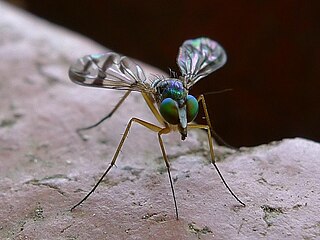Abbemyia is a genus of flies in the family Dolichopodidae, known from Australia and New Caledonia. It is named after the French entomologist Abbé Octave Parent, who studied the family Dolichopodidae.

Austrosciapus is a genus of flies in the family Dolichopodidae. It is mainly found in Australia, though some species are also known from New Zealand, French Polynesia, Norfolk Island and the Hawaiian Islands.
Brevimyia is a genus of flies in the family Dolichopodidae. It contains only one species, Brevimyia pulverea, and is found in New Zealand. It was originally known as Brachymyia, named by Octave Parent in 1933. Later, David Miller found the name to be preoccupied by Brachymyia, and renamed it to Brevimyia in 1945.
Colobocerus is a genus of flies in the family Dolichopodidae, known from New Zealand. It contains only one species, Colobocerus alchymicus. According to Bickel (1992), Colobocerus should probably be treated as a synonym of Sympycnus.
Dytomyia is a genus of flies in the family Dolichopodidae. It is known from Australia, Madagascar and Kenya, with an undescribed species from Papua New Guinea.
Helixocerus is a genus of flies in the family Dolichopodidae. It is known from New Caledonia, American Samoa and Western Samoa.

Heteropsilopus is a genus of flies in the family Dolichopodidae. The genus comprises large-sized sciapodines mostly with a strongly sinuate m-cu and simple digitiform cercus. The strongly sinuate m-cu is considered to be a distinctive group autapomorphy.
Krakatauia is a genus of flies in the family Dolichopodidae.
Mesorhaga is a genus of flies in the family Dolichopodidae.
Metaparaclius is a genus of flies in the family Dolichopodidae. It is known from Papua New Guinea and Australia. The systematic position and monophyly of the genus are currently ambiguous: the holotype specimen of the type species, Metaparaclius subapicalis, was deposited in the Hungarian Natural History Museum, which was destroyed during the Hungarian Revolution of 1956, and no other specimens of this species are currently known.
Narrabeenia is a genus of flies in the family Dolichopodidae, living in Australia and named for Narrabeen, New South Wales.
Naufraga hexachaeta is a species of fly in the family Dolichopodidae. It is the only member of the genus Naufraga, and is found in New Zealand.
Negrobovia is a genus of flies in the family Dolichopodidae found in Australia. It is named in honor of O.P. Negrobov.
Pilbara octava is a species of fly in the family Dolichopodidae from Australia, and the only member of the genus Pilbara. The genus is named after the Pilbara region of Western Australia, where P. octava was found. In particular, the only known location of P. octava is at Millstream, Fortescue River.
Plagiozopelma is a genus of flies in the family Dolichopodidae.
Pseudoparentia is a genus of flies in the family Dolichopodidae. It is known from Australia.
Yumbera is a genus of flies in the family Dolichopodidae, known from eastern mainland Australia and Tasmania. The generic name is an Australian aboriginal word meaning "fly".
Lapita is a genus of flies in the family Dolichopodidae. It is known from New Caledonia, Fiji and Vanuatu.
Humongochela is a genus of flies in the family Dolichopodidae. It is known from three of the Marquesas Islands, with one species on each. All three species are found on vertical surfaces near waterfalls. Flies in the genus have extremely long tarsal claws as well as extremely reduced pulvilli. These are presumed to be evolutionary adaptions to allow better grip on the slippery substrata near waterfalls. The generic name is derived from the American slang "humongous" and the Latin chela ("claw"), referring to their extremely long claws.
Nothorhaphium is a genus of flies belonging to the family Dolichopodidae. It includes four species from Australia and a single species from New Guinea. Nothorhaphium superficially resembles the genus Rhaphium, but it belongs in the subfamily Sympycninae and is thought to be closely related to the genera Syntormon, Parasyntormon and Ceratopos. The name of the genus is derived from the Greek νόθος, and Rhaphium.

